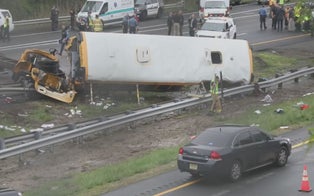At least 160 million Americans in 14 states watched in awe as the phenomenon occurred.
There were the spectacular scenes across the nation Monday as America experienced the historic solar eclipse.
Read: Couple Saying 'I Do' Under the Total Solar Eclipse: 'He Loves the Sun, I Love the Moon'
Crowds gathered on rooftops, city sidewalks, beaches and campsites as an estimated 160 million Americans witnessed in awe as the moon passed in front of the sun turning day into night for a few hours.
All major networks aired live specials on the rare astronomical event.
NASA covered the eclipse with a livestream on the space agency's website, including scenes in an airborne jet.
Crowds stood still at the Crossroads of the World, in New York City's Times Square, where 71 percent of the sun was blocked out.
The crowds were even bigger in regions that reached totality.
It's believed the eclipse will cost nearly $700 million in lost productivity as workers headed outside to watch the phenomenon.
Particular attention was paid to animals and how they would react on the day the sun disappeared.
The Nashville Zoo had a livestream of animals inside their habitats to exhibit their behavior at the time of the eclipse.
Read: What Animal Owners Need to Know About Their Pets Before Eclipse
The last time total eclipse in the U.S. occurred on Feb. 26, 1979. CBS' Walter Cronkite and the late ABC anchorman Frank Reynolds helped broadcast the news 38 years ago.
Reynolds guaranteed an ABC broadcast of the 2017 eclipse.
“Not until August 21, 2017, will another eclipse be visible from North America. That’s 38 years from now. May the shadow of the moon fall on a world in peace. ABC News, of course, will bring you a complete report on that next eclipse 38 years from now,” he said.
Watch: Everything You Need to Know About the Solar Eclipse





